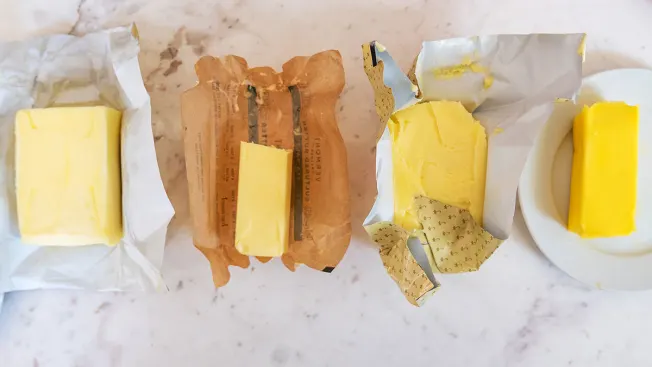Buying raw butter locally offers more health benefits, fresher taste, and a community connection compared to most supermarket butter, which is pasteurize and standardize for mass distribution.
Health and Nutrition
Raw butter is made from unpasteurize cream, retaining enzymes, healthy bacteria, and higher vitamin content. Its nutritional value is tied to grass-fed cows, providing omega-3s, CLA, and natural vitamins A, D, E, and K. This living food supports digestion through active enzymes and probiotics, strengthens the immune system, boosts calcium absorption, and benefits bone and heart health.
Supermarket butter, in contrast, undergoes pasteurization, removing many beneficial bacteria and enzymes. While convenient and consistent, it usually contains less bioavailable nutrition, often missing the subtle health benefits of raw dairy.
Taste and Freshness
Raw butter is recognize for a rich, creamy, sometimes tangy flavor, and a denser, more complex texture. Local, grass-fed variations can also be more yellow and aromatic, reflecting the cow’s seasonal diet. Supermarket butter offers a mild, uniform flavor—ideal for baking, but less distinctive. Local raw butter enjoyment is at its best at room temperature, unlike its supermarket counterparts.
Supporting Local Economies and Authenticity
Buying from local producers connects consumers directly with their food source, supporting ethical practices, regenerative farming, and higher animal welfare. Local raw butter is crafted in small batches, often from grass-grazing cows, and free from antibiotics, synthetic hormones, or GMOs.
Most supermarket butters, even when labeled “grass-fed,” must meet mass production and safety regulations. This results in more stabilized but less dynamic products, usually missing the unique flavor and nutritional shifts of true raw butter.
Searching for “Raw Butter Near Me”
Demand for “raw butter near me” continues to grow. Many specialty dairy stores, farmers’ markets, and online platforms now offer raw butter, sometimes even delivering direct to the consumer. This interest aligns with rising consumer awareness about food purity, fermentation benefits, and traditional diets.
Comparing Raw Shea Butter, Raw Cocoa Butter, and Raw Butter
A closer look at related products:
| Product | Main Benefit | Best Use |
|---|---|---|
| Raw Butter | Healthy fats, probiotics, vitamins for consumption | Cooking, spreading |
| Raw Shea Butter | Linoleic acid, antioxidants for healing and moisturizing skin | Skin, hair, conditioner |
| Raw Cocoa Butter | Long-lasting moisture, polyphenols for skin protection | Skincare, scar prevention |
Raw shea butter excels as a fast-absorbing moisturizer and anti-inflammatory for the skin. It contains vitamin A and E, helpful in restoring damage skin—and is often used in haircare, such as in raw shea butter shea moisture conditioners.
Raw cocoa butter is best for deep, protective moisturization and preventing stretch marks; its scent is a bonus for chocolate lovers. Both are widely use in natural beauty products, especially for their intensive hydration and healing qualities.
Environmental and Ethical Advantages
Choosing local raw butter often supports regenerative agriculture—practices that enrich the soil and environment and result in healthier grass, animals, and ultimately, dairy. Small-batch producers use carbon sequestration, rotate grazing, and avoid synthetic chemicals. These farms typically emphasize animal welfare and environmental stewardship.
Cost and Accessibility
While raw butter sold locally may be slightly more expensive, consumers feel the improved flavor, functionality, and health properties justify the premium. It delivers economic benefit back to regional farmers and artisans, rather than corporate food chains.
How to Use Raw Butters
-
Spread on fresh bread, drizzle over steamed vegetables, or melt for baking—its robust character shines raw or just barely heated.
-
Raw shea butter and raw cocoa butter are use in skin and hair routines: as stand-alone moisturizers, in DIY balms, or as nourishing additions to conditioners like raw shea butter shea moisture conditioner.
-
Always store raw butter refrigerated and consume or freeze promptly for best flavor and safety.
Read More: Benefits of Shea Moisture Conditioner with Raw Shea Butter
Final Thoughts & High Authority Reference
Consumers seeking authenticity, wellness, and community ties are fueling the rise in raw and local butters. While supermarket butter remains an accessible staple, raw butter from local producers offers a richer nutrient profile, bolder flavor, and greater health and environmental benefits. For further information on nutritional differences, consult the Mayo Clinic’s guide on butter varieties, a respected health authority.
Choosing locally sourced, raw butter truly supports wellness from “pasture to plate”—and brings flavor and vitality back to the kitchen and beyond.









